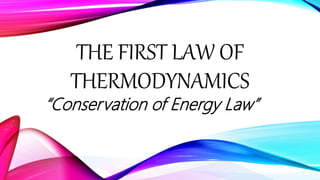The First Law of Thermodynamics
•Als PPTX, PDF herunterladen•
2 gefällt mir•165 views
The First Law of Thermodynamics: Conservation of Energy Law (with equations and sample problems)
Melden
Teilen
Melden
Teilen

Empfohlen
Weitere ähnliche Inhalte
Was ist angesagt?
Was ist angesagt? (20)
Basic mechanical engineering(BMET-101/102) unit 2 (part-2) thermodynamics law...

Basic mechanical engineering(BMET-101/102) unit 2 (part-2) thermodynamics law...
Complete Thermodynamics GATE/IES/All Exams: Chp1 C-3 Property, State, Continu...

Complete Thermodynamics GATE/IES/All Exams: Chp1 C-3 Property, State, Continu...
Ähnlich wie The First Law of Thermodynamics
Ähnlich wie The First Law of Thermodynamics (20)
class11chapter6thermodynamics-230102105503-77b13671.pdf

class11chapter6thermodynamics-230102105503-77b13671.pdf
Mehr von Jm Lucena
Mehr von Jm Lucena (14)
Kürzlich hochgeladen
Kürzlich hochgeladen (20)
Kochi ❤CALL GIRL 84099*07087 ❤CALL GIRLS IN Kochi ESCORT SERVICE❤CALL GIRL

Kochi ❤CALL GIRL 84099*07087 ❤CALL GIRLS IN Kochi ESCORT SERVICE❤CALL GIRL
High Profile 🔝 8250077686 📞 Call Girls Service in GTB Nagar🍑

High Profile 🔝 8250077686 📞 Call Girls Service in GTB Nagar🍑
9999266834 Call Girls In Noida Sector 22 (Delhi) Call Girl Service

9999266834 Call Girls In Noida Sector 22 (Delhi) Call Girl Service
Discovery of an Accretion Streamer and a Slow Wide-angle Outflow around FUOri...

Discovery of an Accretion Streamer and a Slow Wide-angle Outflow around FUOri...
Nightside clouds and disequilibrium chemistry on the hot Jupiter WASP-43b

Nightside clouds and disequilibrium chemistry on the hot Jupiter WASP-43b
Feature-aligned N-BEATS with Sinkhorn divergence (ICLR '24)

Feature-aligned N-BEATS with Sinkhorn divergence (ICLR '24)
GUIDELINES ON SIMILAR BIOLOGICS Regulatory Requirements for Marketing Authori...

GUIDELINES ON SIMILAR BIOLOGICS Regulatory Requirements for Marketing Authori...
Biogenic Sulfur Gases as Biosignatures on Temperate Sub-Neptune Waterworlds

Biogenic Sulfur Gases as Biosignatures on Temperate Sub-Neptune Waterworlds
Seismic Method Estimate velocity from seismic data.pptx

Seismic Method Estimate velocity from seismic data.pptx
The First Law of Thermodynamics
- 1. THE FIRST LAW OF THERMODYNAMICS “Conservation of Energy Law”
- 2. SECTION OBJECTIVES: 1.State the First Law of Thermodynamics. 2.Solve Problems on the First Law Of Thermodynamics.
- 3. What is ENERGY? Energy can be changed from one form to another, but it cannot be created or destroyed. The total amount of energy and the matter in the Universe remains constant, merely changing from one form to another. Energy is closely associated with physical as well as chemical changes.
- 4. Forms of Energy: Potential Energy (stored) Kinetic Energy (in motion) Mechanical Energy (at work) Thermal Energy (heat) Electrical Energy (mobile electrons)
- 5. Internal Energy - the sum of the kinetic and potential energies of its constituent atoms. Heat – thermal energy transferred from a hotter system to a cooler system that are in contact. System work- the quantity of energy transferred from one system to another.
- 6. • The First Law of Thermodynamics: • The increase in the internal energy of a system is equal to the amount of heat added to the system, plus the amount of work done on the system. U = Q + W • The increase in the internal energy of a system is equal to the amount of heat added to the system, minus the amount of work done by the U = Q - W • Q = heat added to system -Q = heat added by the system • W = work done by the system -W = work done on the system
- 8. EVALUATION: 1.) 2500 J of heat is added to a gas under a piston in a closed cylinder, and 1800 J of work is done by the system as its piston expands. What is the change in internal energy of the system? 2.) 2500 J of heat is added to a system, and 1800 J of work is done on the system. What is the change in internal energy of the system?
- 9. Some Vocabulary for Thermodynamic Processes: Isobaric Process (Pressure is constant) P = constant W=P V Isovolumetric Process ( Volume is constant, Work is 0) V = constant Q = [Cv/R (v)][(P2-P1)] W = 0 Isothermal Process( Temperature is constant, I.H is 0) T = constant PV = nRT U = 0 (ideal gas) Adiabatic Process( Heat is 0) Q = O P = v + w
